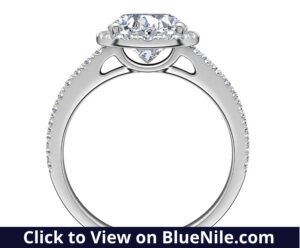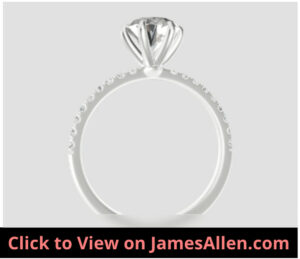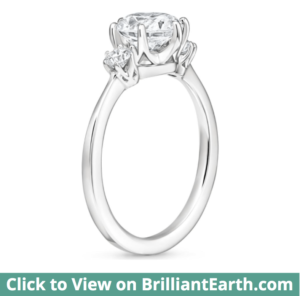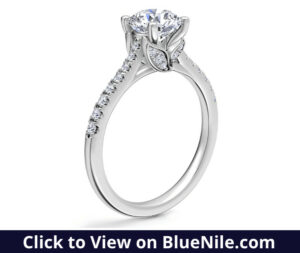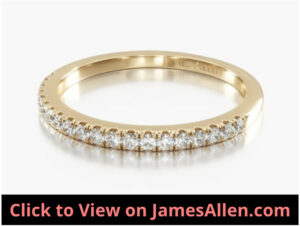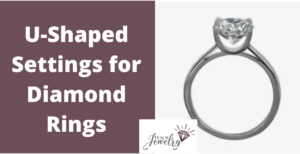
Your choice of diamond isn’t your only decision in selecting the perfect ring. While the center diamond deserves the most attention, spend time finding the right setting.
A U-shaped setting for diamond rings is a modern variation of the traditional prong setting.
We’ll explore everything you need to know about U-shaped settings, including an overview, its pros and cons, the different styles available, and how to decide if it’s right for you.
What is a U-Shaped Setting?
A U-shaped setting features a band that forms a U-shape at the base to hold the diamond.
Prong settings traditionally take an angled approach at the base that extends upward, but a U-shaped prong is rounded at the bottom.
For example, check out this classic halo design that features a U-shaped setting.
Notice how the culet of the round-cut touches the mid-point of the U. Both sides then slope in opposite directions to meet the cathedral arches and halo.
They each work together to hold the diamond in place.
The other type of U-shaped setting is with accents on the band. To add brilliance to the piece, small diamonds cascade down both sides, and they’re often held in miniature U-shaped settings.
To illustrate, here’s an engagement ring that matches this description.
There are 18 accents sitting on the setting, plus the center diamond.
In the U-shaped setting, the diamond isn’t always held in place by the tips of the prong. Instead, the ends are rounded and don’t bend over the diamond’s table as far.
It sits in the U with all of its sides pressed against the prongs.
Pros
Displays More of Diamond
The primary advantage of U-shaped settings is they allow a significant amount of the diamond to be shown.
For those wanting to showcase the center diamond, choose a setting that doesn’t cover up too much of it. Bezel settings, for example, secure the diamond but cover its outer edge.
The U-shaped setting, as long as it’s not a basket style, can display the entirety of all four sides.
Light properly enters and exits the diamond instead of being blocked by the band or prong tips in prominent areas. This creates a higher degree of brilliance for the stone.
Fits a Variety of Cuts
U-shaped settings are also ideal for certain types of cuts, such as:
The shape of these stones fit well with the setting and provide an alternative to how they’re normally held, which is usually with prongs or a bezel.
For example, princess cuts feature four sharp corners. Each sits next to the four prongs usually found in a U-shaped setting.
The same is true of an emerald cut diamond.
Less Likely to Snag
Another advantage of this type of setting is it’s less likely to snag.
One of the downsides of the popular prong setting is its sharp ends can catch on clothing or hair.
This can pull the tips back and loosen the stone.
Prongs on U-shaped settings are often rounded and face upward. They won’t snag as easily during everyday activities.
Cons
Prongs are More Fragile
The first downside is any type of prong setting is more fragile compared to some other settings. Even though it snags less than traditional prongs, the thin metal bands are susceptible to breaking during physical activity.
When the prong’s grip on the stone loosens, it could fall out. If any of the four prongs surrounding your diamond are damaged, don’t wear the ring until it’s repaired.
Always remove your ring before physical activity because that’s when the u-shaped setting is most vulnerable.
Not Available for Every Shape
Secondly, U-shaped settings aren’t right for every diamond cut. While it’s the right fit for round, cushion, and others, you should avoid this type of setting for the following cuts:
- Pear
- Oval
- Heart
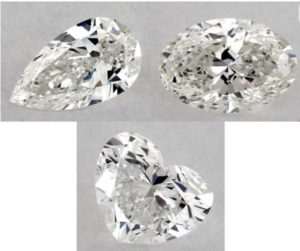
The shapes of these cuts don’t fit as well in the U-shaped setting. A pear-cut diamond’s elongated shape and lack of corners doesn’t allow it to sit well.
The same is true of the oval cut, and the unique dimensions of a heart-cut is best paired with a three- or five-prong setting.
Types of U-Shaped Settings
There are two primary types of U-shaped settings for diamond rings. The first is for engagement rings.
Check out this round-cut engagement ring with a U-shaped setting
Not only does it include that signature design, there are two round-cuts flanking the center one, which are held by prongs that form a V at its base.
It combines multiple styles into one ring.
Engagement ring settings are about showing off the center diamond. It’s why prong settings are the most popular choice.
The U-shape refers to how the bands form a semicircle at the base and extend upward to hold the diamond.
To add more elegance of the ring, diamond accents can also be held by u-shapes. Anywhere from two to 15 miniature U-shaped settings extend down the shank on each side, matching the design of the main one.
The cascading diamonds can be the same cut as the center diamond or contrast it.
Here’s an engagement ring that uses round-cuts for both.
The U-shapes are found on the ring holding the accents instead of on top.
The second type of u-shaped setting is for wedding rings.
Wedding rings don’t focus the attention on a single diamond, so the U-shapes can be featured in an eternity or half eternity band.
Check out this wedding ring in 14K yellow gold.
There are 20 round-cuts sitting in U-shapes for a total of 0.15 carats.
Similar to the cascading diamonds in the engagement ring design, the shank is filled with small U-shaped settings half way around the band, known as a half eternity setting.
They hold diamond accents that add sparkle to the wedding band without competing with the engagement ring.
How to Decide if a U-Shaped Setting is Right For You
U-shaped settings are the right fit for a variety of diamond cuts in both engagement rings and wedding bands.
The subtle difference offered by U-shaped settings has several advantages and provides an alternative to the traditional style prongs.
But be mindful that you’ve chosen the right type of cut.
If you’re looking to match the style of both your engagement and wedding ring, there are U-shaped settings available for both.
The setting and diamonds circling ring won’t detract from the prominent center diamond, and you’ll have a complementary style to wear for a lifetime.

Jacob Clarke
Jacob Clarke is the founder of TeachJewelry.com.
He earned an Applied Jewelry Professional Diploma from the Gemological Institute of America (GIA) and now brings you essential information about diamonds, settings, and more.
Jacob has consulted with leading jewelry brands, and his work has been cited in Clean Origin, Diamond Nexus and industry publications.
He's also a member of the International Gem Society.
He enjoys discussing jewelry with readers, so contact him with any questions at jacob.clarke@teachjewelry.com.

